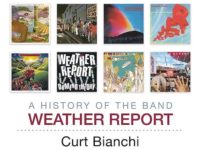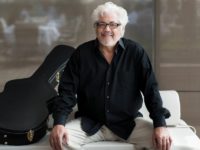A seminal force in the berth of fusion, the versatile Alphonse Mouzon has played drums alongside of dizzying array of jazz greats. Even today, it’s no different.
He worked with Gil Evans on his 1969 release Blues in Orbit, then Roy Ayers at the turn of the decade. Later, Mouzon collaborated with Jaco Pastorius, Donald Byrd and Arild Andersen, then had lengthy stints with McCoy Tyner, Larry Coryell and Herbie Hancock into the 1980s. He was later involved with one of Miles Davis‘ final projects. That’s to say nothing of his underrated fusion dates as a band leader, and the celebrated debut album by Weather Report. Next comes the release this week of Angel Face, a terrific straight-ahead effort featuring the likes of Cedar Walton, Ernie Watts, Christian McBride, Bob Mintzer, Wallace Roney and Arturo Sandoval. More than 10 years in the making, the album is a bold reminder of just how much Mouzon has meant to the development of his instrument, and of the genre itself.
In Part 1 of a SER Sitdown held just before his new project was issued on Tuesday by Tenacious Records, Mouzon talks about playing with Coryell, Tyner, Weather Report and Angel Face — dedicated to this single father’s daughter, Emma Alexandra. We couldn’t leave, of course, without asking about those superfly outfits from back in the day …
Nick DeRiso: The new album Angel Face is a bracing return to the simple joys of straight ahead jazz. After years of fusion, dance music and then smooth jazz, what led you back to that style?
Alphonse Mouzon: Oh, I’m still doing fusion, too! (Laughs.) I’ve been working on that record, as well, over the last 10 years or so. Angel Face was a labor of love, and that’s one of the cuts. It truly was. The next record will be smooth as silk, more contemporary stuff, some funk. That will be an all-star cast of smooth-jazz guys, too. Then, I’ve got a trio thing that will come out in a year or so, something that I did live with me and Larry Coryell and Joey DeFrancesco.
DeRiso: Earlier work with Larry Coryell established your rhythm persona — a great combination of power, style and speed — across a series of albums beginning with 1973’s Introducing the Eleventh House. That was a rawer, more groove-oriented sound than was coming out of John McLaughlin or Chick Corea’s groups of the same period.
Mouzon: We had more soul; it was almost like Southern home cooking. Coming from that R&B background, it was different. That actually started back in 1969, when I touring with Chubby Checker — doing “The Twist” and “Limbo Rock.” (Laughs.) That’s where that started. Later, I went down to a jazz camp at Florida A&M, where I met Cannonball Adderley. He gave me some good advice, when he said: ‘You’ve got to get to New York.’ I paid my dues, played everywhere, and learned a lot. That’s why, as funky as we were, we could still go intellectual. I purposely wrote songs in 7/4th, 5/4th — and wrote a song in 3/4th called “The Funky Waltz.”
[ONE TRACK MIND: Alphonse Mouzon explores signature tunes from Weather Report, McCoy Tyner, Miles Davis, those groundbreaking fusion dates as a leader and his new all-star release, ‘Angel Face’.]
DeRiso: Similarly, that first Weather Report recording still stands out as something more organic than what the band eventually became. Describe how that seminal recording came together.
Mouzon: That’s actually the word I always use, organic. We were a jazz experiment. It was so open. I love that record, not because I am on it, but because it was so different — so refreshing.
DeRiso: You left not long after to join McCoy Tyner. Was that just too interesting to pass up, even with the success you’d had with Weather Report?
Mouzon: It was a coming to an end. After our tour of Europe, I wasn’t that happy with the situation. We were ready to part ways, anyway. So, it was perfect when I went with McCoy. I ended up doing four records with him. It was so open and free.
DeRiso: Mind Transplant, from 1974, has been called one of the best fusion records of all time. Describe the contributions from Tommy Bolin, who had played with Deep Purple and Billy Cobham’s Spectrum.
Mouzon: He made that record, along with Lee Ritenour. There were actually three guitars, with Jay Graydon. I heard Bolin on the Spectrum record and I wanted him on guitar. We had met before, when we sat in back in Boulder in 1974. I had the night off and sat in. So when I went back to New York and heard Spectrum, I had to have him. That was great. I just let him stretch.
DeRiso Your legend is built around working as a drummer, but you played everything from guitar to flute as a kid — and were featured on organ and synthesizer on classic albums like Mind Transplant, as well. Now, Angel Face finds you on the trumpet. Is there anything you don’t play?
Mouzon: I just finished a song that I wrote for a my dog, ‘Little Princess.’ That’s a solo flute feature. I get too bored to just play the drums. I’m self taught. When I was in high school growing up in Charleston, South Carolina, I began messing around with the piano, the xylophone, marimbas. When I went to New York, I had a piano in my room. I was a drummer but I didn’t have any drums! (Laughs.) So, I agreed to help be a roadie for the organ player in a big band (theRoss Carnegie Society Orchestra) that was playing across the street, and they let me play a few numbers. That was Larry Young; he played like McCoy Tyner. A very different type of organ player, so free. It was great. I picked up things along the way.
DeRiso: There were other rock connections. Robert Plant, in his acceptance speech on behalf of Led Zeppelin at the Rock and Roll Hall of Fame, named you as one the band’s principal influences.
Mouzon: John Bonham (Zeppelin’s late drummer) would listen to me all day, so they all knew me. This guy used to come and see me and Larry Coryell at the Bottom Line. Even today, Jimmy Page and Larry are good friends. Hanging out with those guys was great. Mixing rock and jazz came easy. You heard more of that stuff back then. I used to hang out with Yes, at Jon Anderson’s house. I got into to Indian food through Yes. I had never had that before. It burned like hell at first, but I have ended up eating it ever since. We listened to each other’s music. I have always been a rocker — and those guys wanted to play jazz.
DeRiso: 1975’s The Man Incognito is as memorable to me for the cool fashion on the cover as for the music. Do you still have those outfits?
Mouzon: That was high fashion! I still have all of those outfits. They are in storage. I have lost about 35 pounds; so, I am going to get back into those outfits one day. I might look like a fool, but I had that before Huggy Bear (the character played by Antonio Fargas on the 1970s TV show “Starsky and Hutch”). My daughter knows where she gets her fashion sense, from looking at my old CDs and album covers. I find her some hip stuff at the store. I ask her if she tells her friends that her dad picked that out. (Laughs.) Hey, I saw Bootsy Collins last year and he’s still wearing that stuff — and he’s cool. I figure I can come back with that, too!
[amazon_enhanced asin=”B0050POKZQ” price=”All” background_color=”FFFFFF” link_color=”000000″ text_color=”0000FF” /] [amazon_enhanced asin=”B000002868″ price=”All” background_color=”FFFFFF” link_color=”000000″ text_color=”0000FF” /] [amazon_enhanced asin=”B00008CLMX” price=”All” background_color=”FFFFFF” link_color=”000000″ text_color=”0000FF” /] [amazon_enhanced asin=”B000000YHG” price=”All” background_color=”FFFFFF” link_color=”000000″ text_color=”0000FF” /] [amazon_enhanced asin=”B003EPBQ74″ price=”All” background_color=”FFFFFF” link_color=”000000″ text_color=”0000FF” /]
- Nick DeRiso’s Best of 2015 (Rock + Pop): Death Cab for Cutie, Joe Jackson, Toto + Others - January 18, 2016
- Nick DeRiso’s Best of 2015 (Blues, Jazz + R&B): Boz Scaggs, Gavin Harrison, Alabama Shakes - January 10, 2016
- Nick DeRiso’s Best of 2015 (Reissues + Live): John Oates, Led Zeppelin, Yes, Faces + others - January 7, 2016




